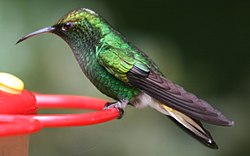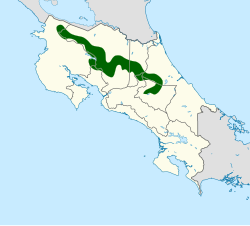| Coppery-headed emerald | |
|---|---|
 | |
| Scientific classification | |
| Kingdom: | Animalia |
| Phylum: | Chordata |
| Class: | Aves |
| Clade: | Strisores |
| Order: | Apodiformes |
| Family: | Trochilidae |
| Genus: | Microchera |
| Species: | M. cupreiceps |
| Binomial name | |
| Microchera cupreiceps (Lawrence, 1866) | |
 | |
| Range of M. cupreiceps | |
The coppery-headed emerald (Microchera cupreiceps) is a small hummingbird in the "emeralds", tribe Trochilini of subfamily Trochilinae. It is endemic to Costa Rica. [3] [4]




